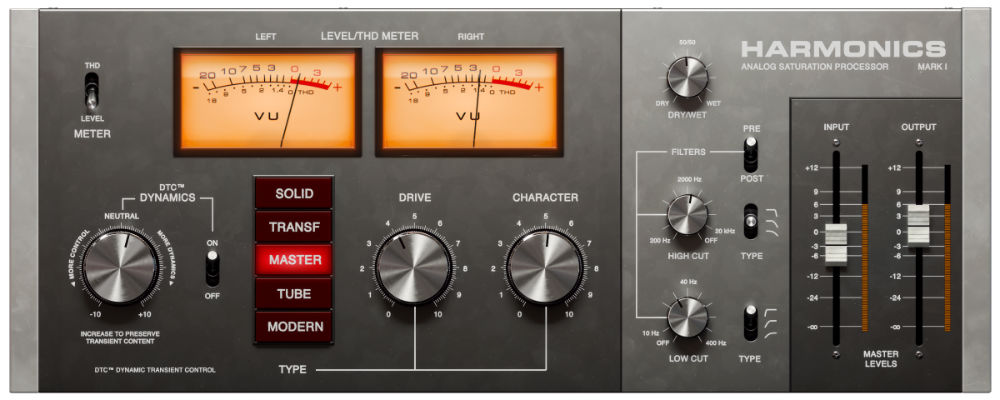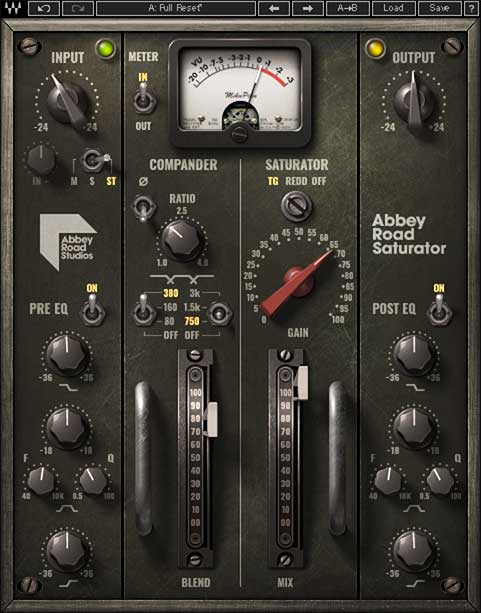Best Distortion Plugins & Saturation VSTs of 2022

Let’s face it, every musician wants to turn heads and maximize their creative expression with their sound. How do you achieve this in a way that doesn’t break the bank? Simple.
Distortion and saturation plugins!
Long story short, these plugins add frequencies in a certain way to make a track sound like it was recorded in a multimillion-dollar recording studio. In this article, you will learn about the best distortion and saturation plugins plus a few alternatives so you can take your music to the next level.
Note: This article may contain affiliate links, meaning I would receive a commission - at no cost to you - for any products you purchase.
Best Distortion Plugin – FabFilter Saturn
From warm and clean saturation to chaotic and extreme distortion, FabFilter Saturn delivers on both ends of the spectrum and everything in-between to elevate your music. Saturn has a slew of modulation options. For example, you can choose from over 150 ready-to-go killer presets or you can configure your own custom presets. In addition, Saturn is very simple to use–just drag and drop for most of the software’s actions!
There are sixteen distortion styles ranging from soothing saturation to heavy guitar screams. The modulation options are essentially limitless. Saturn also gives you access to MIDI sources, XLFOs, XY controllers and envelope generators. Lastly, Saturn comes with fun features such as interactive hints, MIDI Learn, precision-tuned controls and much more.
Overall, the FabFilter Saturn is a one-stop-shop for all distortion and saturation needs for any musician.

Pros of the FabFilter Saturn:
- Incredibly powerful multi-band sound sculpting choices
- Multiple distortion styles
- Modulation options
Cons of the FabFilter Saturn:
- CPU intensive
Best Saturation Plugin – SofTube Harmonics
SofTube's Harmonics has become my go to saturation plugin over the past year. It sounds incredible, has a beautiful interface, and is incredibly easy to use. Even better, it's usually on sale for less than a $100!
To start with, Harmonics includes a powerful, unique feature: a transient shaper. It can be used to either add more punch to your signal or to take some punch away. Adding a touch of punch is a lifesaver if you're trying to saturate an 808. Removing some of the attack on a saturated synth can help from making it too shrill.
Next, Harmonics includes five different saturation modes:
- Solid
- Transformer
- Master
- Tube
- Modern
Each mode adds its own unique take on saturation, and it's worth experimenting to see which is the best for for each instrument. My favorites are Solid, Master, and Tube. You can further dial in your sound by adjusting the amount of drive for the saturation mode. On top of that, you can adjust the character of the distortion, essentially brightening or darkening it.
Finally, Harmonics also includes adjustable high- and low-pass filters and a wet/dry knob for blending in the perfect sound.
Pros of SofTube Harmonics
- Great sound
- Powerful transient shaper
- Fast and easy
Cons of SofTube Harmonics
- None
Best Saturation Plugin Under $100 - RC-20
RC-20 Retro Color is a creative touch plug-in that brings life and texture to any closure. Not only does it easily recreate the warm, cozy feel of vintage closures, it also works perfectly in modern production environments.
Inspired by classic gear, it adds shine and texture. RC-20 is ideal for drums, guitar, keyboards, bass and all mixes. Plus, the Flux Engine adds a warm, analog-style feel.
RC-20 includes 6 unique effect modules that can emulate everything from vinyl to VHS tape, adding noise, vibration and dropout to your tracks. Raw distortion and bit crushing can reduce extra bass or drum roughness. Spatial and chorus effects make your guitar sing like never before, and filter effects are perfect for the most modern beats.
The Flux Engine adds subtle (or not-so-light) wobble and flutter to any FX module, giving it the character, warmth and comfort of last year's best tech.
The layout it complex, but intuitive. The large slider controls the intensity of the entire function. Even when searching for presets, they're still easily accessible, making it easy to find the perfect sound and beyond. Automate these controls for great intros, highlighting key phrases, or adding transitions to your music.
Get the right work experience, including presets for drums, keyboard, guitar, bass, full mixes, and after production. The RC-20 interface invites experimentation and gives you access to the accessibility of each FX module during inspection.
Pros of the RC-20
- Massively flexible sound design
- Huge range of tones
Cons of the RC-20
- Too many options?
Best Cheap Saturation Plugin - Waves Abbey Road Saturator
Abbey Road Studios: The sound of legendary tapes and tubes, driven hard from inconspicuous to in-your-face, and powered by the super unique EMI TG12321-a distinct tool of Abbey Road engineers.
The Abbey Road Saturator models this classic preamp, which adds warmth and satisfying musicality to a drum or vocal part; but it can also make a synth, bass or guitar part 'sing' in the mix.
With a cool, vintage interface with some modern flair, the Abbey Road Saturator gives immerses you in this classic gadget. The module offers two adaptable modes: the crunchy tube REDD sound, and the solid state TG12345 tone-with the both aligned flawlessly by Abbey Road's specialists.
It sounds great, it's super cheap (usually under $40), and can allow you to quickly dial in the perfect amount of warmth. The Abbey Road Saturator also features a built in commander and a simple EQ for more tone-shaping goodness!
Best Saturation Plugin – SoundToys’ Decapitator Analog Saturator
SoundToys’ Decapitator is the weapon of choice among top audio engineers. Analog saturation is a little-known secret to make average recordings sound amazing. The Decapitator ticks all the boxes of an amazing analog saturation emulator.
The plugin emulates the the dynamics of real vintage gear. It encompasses the whole spectrum of harmonics, so any musician can quickly and easily add layers of subtle harmonics, or if the situation calls for it, the musician can flick the ‘Punishment’ button and unleash a destructive attacking tone.
The Decapitator features five different emulation modes and has a very simple, easy to use layout featuring the standard analog knobs. It also features a Wet/Dry knob to dial in just the right amount of saturation. Try just a touch of saturation to bring your bass to life in the mix, or smash the drum room mics for a huge, aggressive tone.
Pros of the Decapitator Analog Saturator
- Easy to use
- Incredible analog saturation emulation
- Tons of tone shaping possibilities
Cons of the Decapitator Analog Saturator
- None
Free Saturation Plugin – Softube Saturation Knob
For those musicians just starting out or looking for a free saturation plugin to get a feel for the device, Softube’s Saturation Knob is hands down the best option. This free, simple software is available for download straight from SoftTube’s website.
It’s the perfect solution to fatten up a guitar or bass track, add smooth harmonics to vocals and much more. There are three saturation modes to choose from and it can work as a DAW insert. The tool features one simple knob to control the saturation level. The SoftTube saturation knob is a great addition to a musician’s DAW for absolutely no cost.
Pros of the SoftTube Saturation Knob
- Free
- Simple
- Sounds Great
Cons of the SoftTube Saturation Knob
- Simple
- Limited tone shaping qualities
Best Tape Saturation Plugin – U-he Satin Tape Machine
The absolute best tape saturation plugin on the market is the u-he Satin Tape Plugin. The world-class u-he team spent months of research and painstaking measurement to develop this plugin which magnificently captures the magic of magnetic tape machines. The Satin gives you access to a selection of emulations from all major historical developments in tape technology.
All functions are available in one simple easy to use panel. Functions include all of the best features of tape including HF compression, transient-smoothing and saturation with full control over asperity noise, head-bump, wow and flutter, etc.
The Satin comes with extra effects such as 4-tap stereo delay and a flanger. If you haven’t experienced the magic of tape, u-he Satin will have you never looking back. If you want to see a line up of all of the best tape emulation plugins, check out my in-depth review.
Pros of the U-He Satin Tape Machine
- Pristinely modeled tape machine with saturation shaping tools
- Multiple styles of tape
- Additional effects like tape delay and flanging
Cons of the U-He Satin Tape Machine
- None
Best MultiBand Distortion Plugin – Izotope Trash
There’s no better way to mangle your tracks than with the iZotope Trash 2 distortion plugin. In fact, this distortion tool is a main weapon in the arsenals of famous bands including Nine Inch Nails and Korn.
Izotope Trash is equipped with tons of distortion algorithms, presets and impulse responses. It includes other sound mangling tools like dynamic control and a delay, and multiple filters. Plus it has a built in Wet/Dry knob.
Izotope Trash also gives you the ability to build your own distortions with the customizable multiband waveshaper. The impulse responses allow you the freedom of putting your track into any acoustical space you can think of.
For example, you can put your bass in a tunnel or your snare drum in a cave! There’s 100 impulse responses to experiment from and you can customize your own. Overall, feel free to trash your other plugins and make way for Izotope Trash.
Pros of iZotope Trash 2
- Incredible control
- Ability to complete mangle sounds
- Further shape sounds with impulse responses
Cons of iZotope Trash 2
- Complicated
Powerful Sound Destruction Unit - Scream 4
Updated 4/25/21: Reason 11 Intro has been discontinued. Scream 4 is still available as part of the full version of Reason.
The Scream 4, which is a part of Reason, is a cost-effective solution for any musician looking for a versatile and high quality plugin. Not only is Scream 4 one of the best distortion plugins in its own right, but it comes bundled with an entire DAW, killer synths like Europa, and a ton of other effects and samples. If you want to know more about how to use Reason, this article will help you get started.
The Scream 4 features a three-band EQ section and a phenomenal sound destruction unit to use for digital bit crushing or adding warm analog. This affordable plugin also has ten different distortion types including fuzz, overdrive, tape, tube, feedback, scream, warp and more.
The scream and overdrive settings will add bite and aggressiveness to your sound while tape and tube settings will create a warm and charming aura. You can tweak the damage section of the plugin with the P1 (resolution) and P2 (sample rate) knobs.
There is also a Damage Control knob which directly affects the level of distortion applied to the audio. And it also includes the ability to modulate its key parameters via CV voltage. Overall, the Scream 4 plugin is an effect unit in a class of its own that can completely change the sound of a piece of music with a simple flick of a switch.
Pros of Scream 4 Distortion
- Versatile sound destruction tool
- Simple controls
- Easy on the CPU
Cons of Scream 4 Distortion
- Has to be run inside the Reason Effect Rack
Alternatives – DAW Distortion Units and Guitar Pedal Simulators
Don't feel like you can only run guitars through amp simulators and pedal plugins. These can be great creative tools for vocals, synths, basses, and more!
External plugins are not the only way to access distortion and saturation FX for your tracks. Many DAW’s including GarageBand and Logic Pro X have built-in distortion units free to use in most cases which are surprisingly adequate.
Also, many guitar pedal simulators have a similar effect. Guitarists don’t need hardware to get the sounds they love since they can download a piece of software to use their favorite fuzz and distortion pedals.
For example, the BIAS Pedal gives you the ability to design your own pedal and access countless presets to experiment with. I've also got a review of the best guitar amp VSTs. Adding a guitar amp can often be that secret sauce to bringing distortion and saturation to life.
Distortion Plugin FAQ
What is Distortion?
Distortion in the most general sense are any frequencies that deviate from the original audio waveform. This means almost any audio process such as compression and equalization can be considered distortion.
However, when most people speak of distortion they usually mean the dirty and gritty overtones that are heard from a wailing electric guitar where there is a large amount of deviation from the natural waveform.
What is Saturation?
Saturation is a type of distortion that adds warmth to a tone by adding harmonics to a given track.
Distortion vs. Saturation
In short, distortion is angry saturation. Both saturation and distortion add frequencies to a waveform to alter its sound. However, distortion is generally when you add random frequencies to a waveform which gives it a ‘dirty’ sound. Saturation is a type of distortion. Saturation typically has harmonic relation to the original waveform or sound which results in a warm and soft sound.
Saturation vs. Tape Saturation
Saturation is the addition of harmonic frequencies to a track giving it warmth. Tape saturation is a type of saturation which is another term for analog tape recording where the voltage level exceeds the tape’s ability to record it.
Tape saturation recreates the sound that resulted when saturation was added to physical tape recordings prior to digital mixing. Many musicians believe digital production lacks the depth and presence of analog recordings, so tape saturation plugins aim to recreate this authentic analog sound.
What is MultiBand Distortion
Multiband processing splits a waveform into multiple frequencies such as lows, lower mids, highs, etc. and allows the musician to process each frequency individually. For example, a guitarist can record the full spectrum of the instrument from the low E string to the high E string and add distortion to each individual frequency. When these are combined together, it creates a magnificent sound that is rich and full.
From a Frustrated Producer in a Ragtag Bedroom Studio to Major Placements on TV Earning $1,000s!
My name is Evan, and I've been making music since around 3rd grade. I'm from San Diego, California, but I've lived in Washington, DC for the last 20 years.
While I still have a full-time day job, I have created systems that have allowed me to produce dozens of songs a year in my spare time.
My songs have been on Netflix, TV shows like the 90 Day Fiance, an award-winning indie film, and NPR’s “All Thing Considered.” They've also been streamed millions of times.
In addition to being a music producer, I am passionate about teaching people how they can make professional-sounding music and earn money licensing it, all in their spare time.
Thousands of musicians, like yourself, have trusted me to guide their musical journey. My YouTube videos have been watched nearly a million times. And my story has been in Forbes, Side Hustle Nation, and the Side Hustle School.















